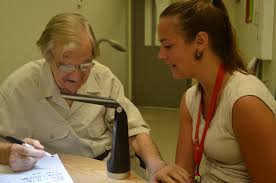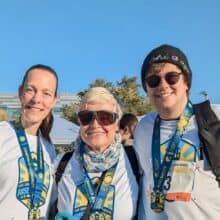
Happy National Occupational Therapy Awareness Month!
April is National Occupational Therapy month. Celebrated since 1980 by The American Occupational Therapy Association, it aims to create awareness about this broad and growing profession and about how occupational therapists help individuals live life to the fullest. People with vision loss of all ages can benefit greatly from working with OT professionals. This week I spoke with Laura Hayes, an occupational therapist at The Chicago Lighthouse for five years, and she shared with me some of the many ways in which OT can help those with low vision.
Occupational therapists work with people of all ages who have all types of disabilities and health conditions. Treating patients with vision loss is a specialized and emerging area, and currently few therapists work specifically with this population. As with any other patients, the therapy is tailored to their needs and lifestyle.
“We’re really looking at how can we teach individuals how to compensate, how can they adapt with their vision, how might they be able to modify their environments or some of the tools they use so that they’re still able to complete those daily activities that are meaningful to them,” said Laura. It all comes down to talking with patients about their goals and figuring out a plan so they can resume their activities without having to give them up because of their visual impairment.
Occupational therapists focus on working with patients on what is known as sensory substitution, or teaching them how to use audio and tactile devices. If a person has a severe vision impairment, then he or she might benefit from using devices like talking watches or labeling their microwave or washing machine with tactile markings.
Lighthouse occupational therapists also teach patients how to use magnifiers or other optical devices recommended by optometrists at our low vision clinic. They teach them, for example, how to read the label on a can of soup with a magnifier. Contrast is another area where patients often need help. Simple things like chopping a white onion on a black cutting board or putting contrast tape on the edge of stairs can make life easier and safer at home for patients with low vision.
Therapists often spend time in patients’ homes to get a better sense of their needs and environment. Laura says that the biggest advantage to this is that they can actually see firsthand the areas of difficulty and how they can help each individual. The majority of her patients are seniors with eye conditions like age related macular degeneration, glaucoma and diabetic retinopathy. She occasionally also sees younger patients. While she does not work with children with visual impairments, other occupational therapists do specialize on this population.
For Laura, occupational therapy has been a very rewarding profession.
“It’s a very fulfilling career, because you get to help people and there are so many ways you can go with it, so many people you can work with.”
She says that many patients are also extremely appreciative for the help they receive by working with occupational therapists.
“I’ve really had people say ‘I felt like there was not a lot of hope for me, I didn’t know what I could do… and now after coming to the Lighthouse… I realize there’s a lot of stuff I still can do.’”
For more information on how occupational therapy helps patients with visual impairment, visit this page from the American Occupational Therapy Association. To find out more about The Chicago Lighthouse’s low vision clinic, visit this link, or call 312-997-3668.





